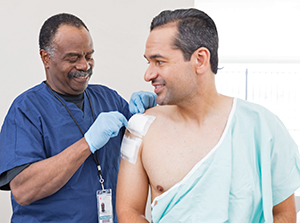How Wounds Heal

Most of us take wound healing for granted. If you get a small cut, you may clean and let it open to the air or cover it with a bandage, and move on with your life. Yet under that bandage or in the open air, the body orchestrates a complex cascade of events designed to heal wounds big and small.
Steps to wound healing
Step 1: Stopping the bleeding (hemostasis)
When your skin is cut, scraped, or punctured, you usually start to bleed. Within minutes or even seconds, blood cells start to clump together and clot, protecting the wound and preventing further blood loss. These clots, which turn into scabs as they dry, are created by a type of blood cell called a platelet. The clot also contains a protein called fibrin, which forms a net to hold the clot in place.
Step 2: Inflammation
Once the wound is closed with a clot, the blood vessels can open a bit to allow fresh nutrients and oxygen into the wound for healing. Blood-borne oxygen is needed for healing. The right balance of oxygen is also important — too much or too little and the wound won't heal correctly. Another type of blood cell, a white blood cell called a macrophage, takes on the role of wound protector. This cell fights infection and oversees the repair process. You might see some clear fluid on or around the cut at this time. That is helping clean out the wound. Macrophages also make chemical messengers, called growth factors, which help repair the wound.
Step 3: Growth and rebuilding
Blood cells, including oxygen-rich red blood cells, arrive to help build new tissue. Chemical signals tell the cells to create collagen. It serves as a type of scaffolding. Occasionally, you see the result of this process as a scar that starts out red and eventually dulls.
Step 4: Strengthening
Over time, the new tissue gets stronger. You might notice stretching, itching, and even puckering of the wound as that happens. The wound gains strength quickly over the first 6 weeks of healing. In about 3 months, the wound is 80% as strong in its repair as it was before the injury. But the wound area will never reach 100% of its original strength. Depending on the size and the severity of the wound, the entire healing process might take up to a couple of years to complete.
Interrupted wound healing
The process seems simple enough, but wound healing is really quite complicated and involves a long series of chemical signals. Certain factors can slow or prevent healing entirely.
One of the most dramatic factors that can affect wound healing is reduced or poor blood supply to the wound. The oxygen and nutrients that new blood carries to the wound are key to successful healing. A wound that is not getting enough blood could take at least twice as long to heal, if it heals at all. These are called chronic wounds. These are more common in elderly people or people with diabetes, high blood pressure, obesity, or other vascular disease. People who smoke are at high risk for poor wound healing.
If you have a wound that is not healing in a reasonable time frame, make an appointment with your healthcare provider. If your injury seems to be getting worse or appears infected — that is, if it is more swollen, warm or hot to the touch, painful, or draining/oozing pus — see a healthcare provider right away. If you smoke, ask your provider for resources that will help you quit.